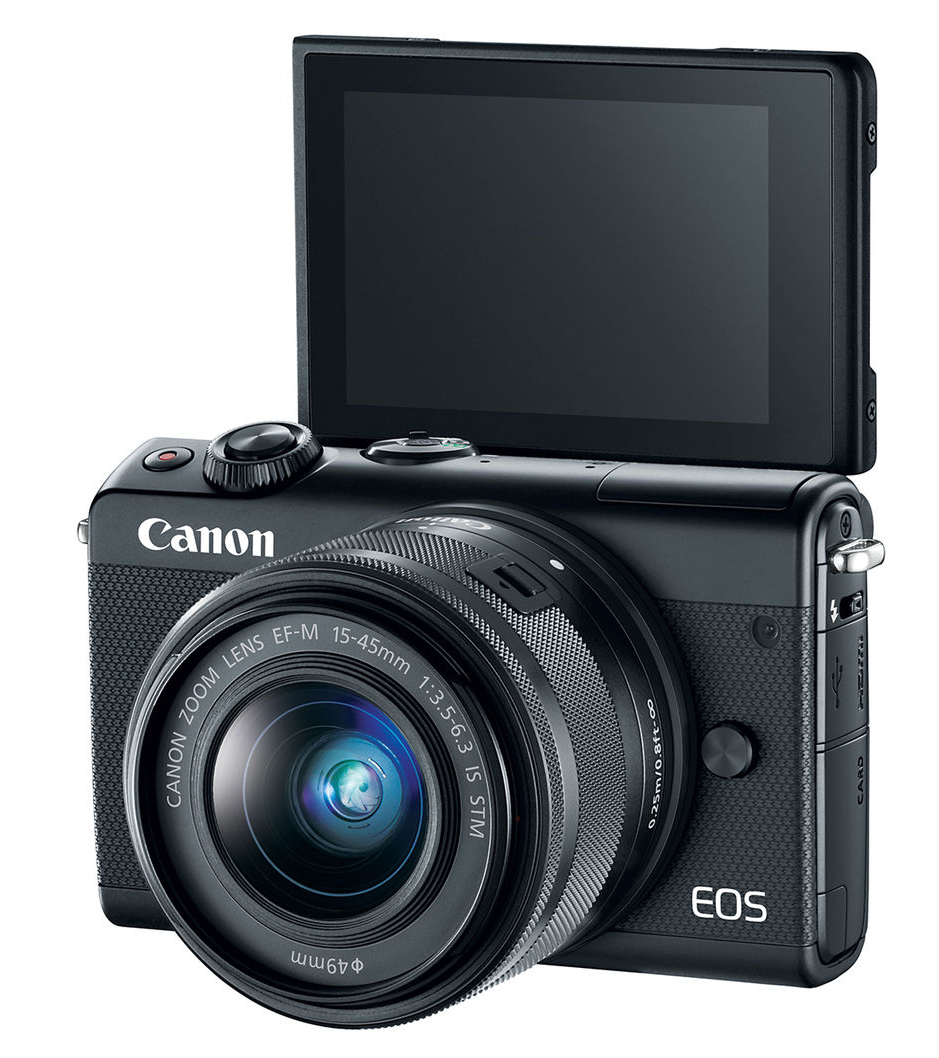
- New Canon EOS M100 Announced! Looks like a winner to me!
The new Canon EOS M100 has been announced and honestly, it is the 1st EOS M camera that interests me. I will tell you why.
It’s small. It will have blazing fast AF with its Dual Pixel CMOS AF. It will be great with photos, and superb for video. Has a nice 3″ 1.04M dot touchscreen LCD. Can be used with EF and EF-S lenses via adapter. The new sensor for me, is perfect at 24MP. IN this day and age of $2,3,4,5 and even $10k digital cameras, this one comes in at $949 with a lens. Sure, you can buy a Micro 4/3 setup for that or less, and a starter Fuji but this system seems to have finally matured with dual pixel AF which is quite amazing IMO. It’s APS-C so no 1″ sensors here.
So small size combined with speed, refinement and the ability to use some of the best L Glass via adapter along with shooting video for personal use, or vlogging, this EOS M seems mature, finally ; ) I also love the flip up screen, Ala the Sony RX100. For those who love selfies, this camera will be a great selfie machine. I will be reviewing this camera soon, so stay tuned! BTW, I am still waiting for a kick ass Canon and Nikon mirrorless that will compete against Sony and Leica and Fuji and Olympus!
Features are below…but you can PRE ORDER it HERE at B&H Photo.
- 24.2MP APS-C CMOS Sensor and DIGIC 7 Image Processor
- Both a 24.2MP APS-C CMOS sensor and DIGIC 7 image processor are used to deliver high sensitivity and fast camera performance to suit both stills and video applications. A flexible ISO 100-25600 range suits working in a variety of lighting conditions, and the processing capabilities minimize noise for notable clarity. The processor also contributes to a fast 4 fps continuous shooting rate, which can be quickened to 6.1 fps with AF lock, for photographing fast-moving subjects. Full HD 1080p video recording is also supported at up to a 60 fps frame rate. Additionally, the processor affords a fast camera startup time and short interval times between each frame for a more intuitive and efficient shooting process.
- Dual Pixel CMOS AF
- Dual Pixel CMOS AF offers smooth and fast focusing performance in a similar manner to how a camcorder acquires focus. This system integrates two separate photodiodes within each pixel to provide a broad and dense network of phase-detection gathering elements across a majority of the image sensor to reduce focus hunting for faster, more direct control of focus placement. When working with still imagery, this focusing system works to acquire focus quickly and accurately, making it ideally suited to shooting and tracking moving subjects so that critical focus is attained with each shot. When shooting video, a Movie Servo AF mode offers smooth and natural focusing when changing from different subjects or different distances within the scene, as well as the ability to specify tracking sensitivity, AF speed, and Face Tracking priority. Benefited by the Touch AF system, rack focus is possible simply by touching elements within the scene on the touchscreen in order to change focus in an intuitive manner. Subject tracking in movies is also heightened due to the Dual Pixel CMOS AF system’s ability to recognize subjects and maintain focus when working within changing or cluttered scenery.
- Body Design and Built-In Wi-Fi
-
- Large 3.0″ 1.04m-dot touchscreen LCD provides an intuitive method for controlling focusing points, navigating menus, and reviewing imagery. This screen also features a tilting design (180° upward, 45° downward) to better enable working from high and low angles.
- Built-in Wi-Fi with NFC allows for easy wireless sharing of both photos and movies to a linked mobile device.
- Bluetooth permits linking a smartphone or tablet for quick image sharing between devices as well as remote control capabilities.
- Through the use of an optional adapter, the M100 is able to work with EF and EF-S mount lenses.
- Other Features
-
- Creative Assist lets you adjust settings and preview the effects in real time. Personalized settings can be stored for quickly replicating a look, and imagery from other photographers can be imported into the M100 and have the specific exposure settings displayed in order for you to replicate the look and learn how different settings affect the results.
- Benefitting from the 180° tilting touchscreen LCD, a Self-Portrait Mode allows you to make in-camera enhancements to your selfies. Adjustments include smoothing skin tones, blurring the background, and modifying the overall brightness of the scene. A customizable self-timer can also be set in this mode to give you the right amount of time to prepare for your shot.
- EF-M 15-45mm f/3.5-6.3 IS STM Lens
- Included with the camera body is the versatile standard zoom EF-M 15-45mm f/3.5-6.3 IS STM lens, which provides a 24-72mm equivalent focal length range. Three aspherical elements help to control chromatic aberrations and distortions throughout the zoom range and an optimized lens placement works to reduce flare and ghosting. An Optical Image Stabilizer works to minimize the appearance of camera shake by up to 3.5 stops for sharper handheld shooting and an STM stepping motor provides fast, smooth, and near-silent autofocus performance.
- EF-M 55-200mm f/4.5-6.3 IS STM Lens
- Also included in the kit is the telephoto zoom EF-M 55-200mm f/4.5-6.3 IS STM lens, which provides an 88-320mm equivalent focal length range. One aspherical element and one Ultra Low Dispersion (UD) element help to reduce aberrations throughout the long zoom range and an Optical Image Stabilizer minimizes the appearance of camera shake by 3.5 stops to benefit working with slower shutter speeds. Additionally, an STM stepping motor delivers quick, quiet, and smooth autofocus to suit both stills shooting and video recording applications.

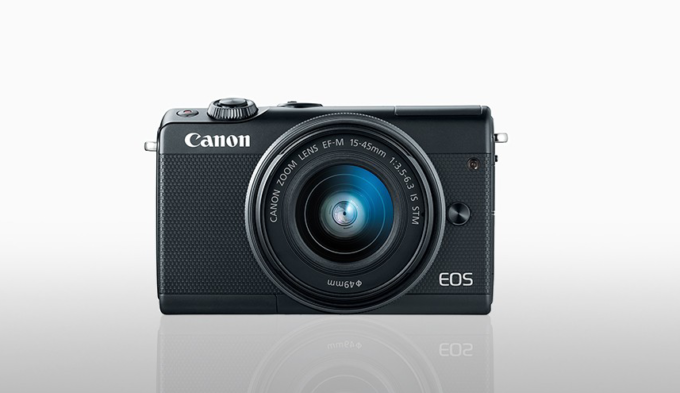
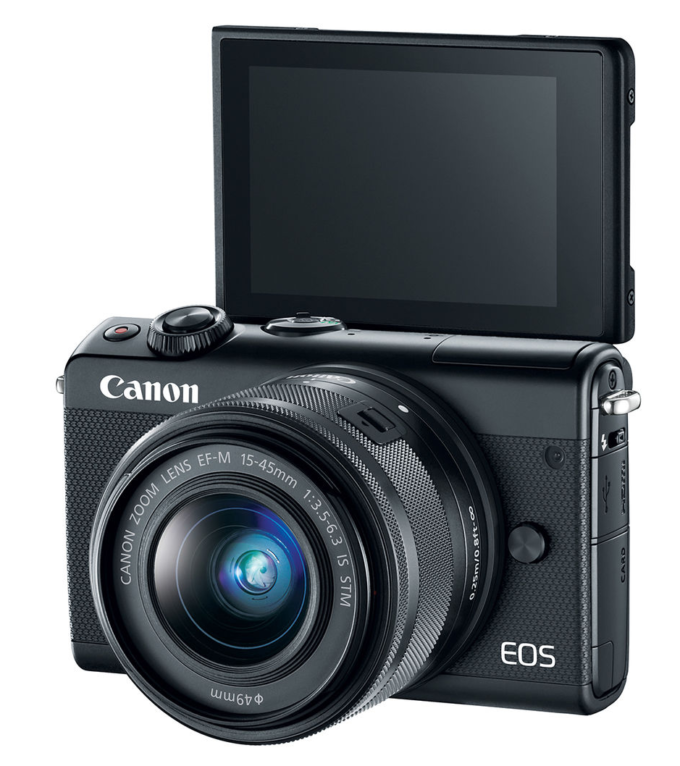
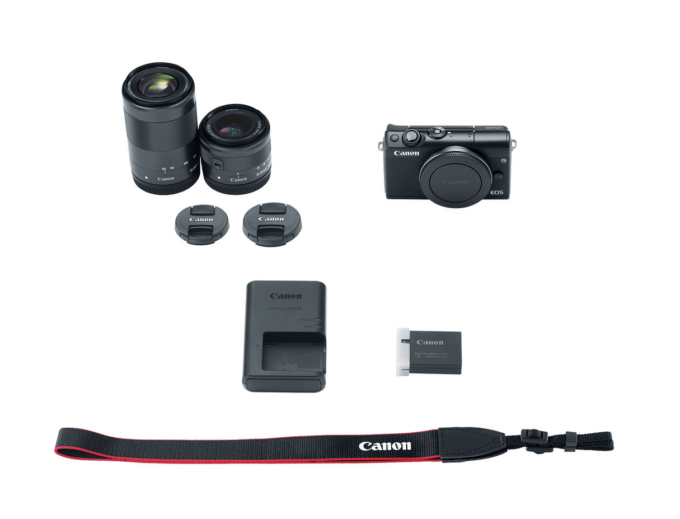

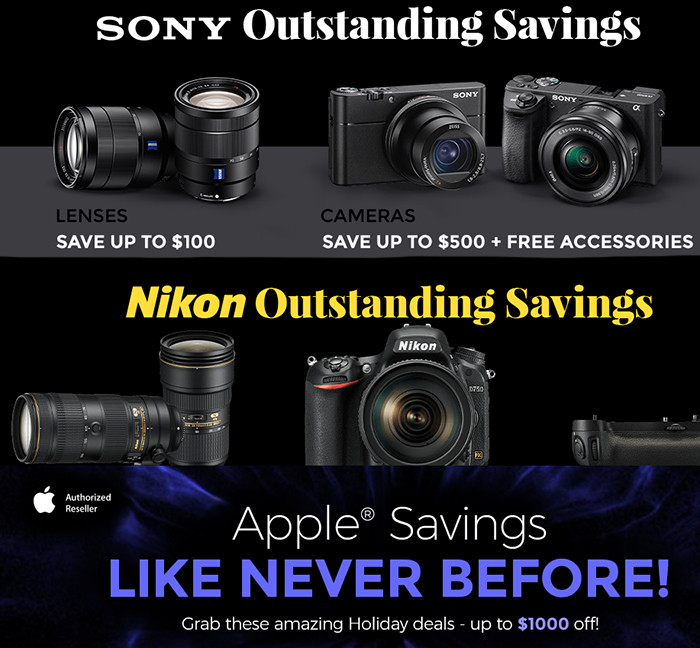

For the same price you can get the a6000, a camera with much better lens selection and a Viewfinder.
Yes but not this small with a lens like the 22mm. Sonynoancake lenses for the e- mount are really bad.
No viewfinder, no sale. Enjoy using that back screen in bright sunlight…
I hope there is a good pancake lens option. Compared to the body those lenses are huge.
There’s the 22mm f2.0 (about a 35mm equiv).
Steve- wow looks like you and I agree on something like this for once 😉
It also caught my attention. It’s actually cheaper than $949 – that’s with not one but two lenses! The single lens kit is only $600!!!!!
One Canon first inreally wanted – in camera raw converter! Finally Canon.
Wish it had no AA filter.
What is amazing to me is that this is an apsc phase detect capable for $600 and small. I have been waiting for Panasonic to build a “gm7” with the new 20MP sensor but they didn’t.
Three issues though – 1 no silent shutter (electronic shutter) To me thisnis a deal breaker depending how the regular shutter sounds.
. 2- this camera needs at least two more primes like the f2.0 22mm it has really bad. At least the same type but portrait.
3 – the other lenses other than the wide zoom aren’t that great.
Re: “…the other lenses… aren’t that great”. You are misinformed, I might suggest. The EF-M 28mm/3.5 macro is superbly corrected for a usefully flat field, low distortion, and minimal aberrations; and online images** from this uniquely practical, short focal length 1:1.2 true macro lens give every indication of having a see-through transparency, natural looking 3D pop, notable micro-contrast, and “roundness” in the object rendering which is rare enough at multiples of the cost… particularly from “fast”, heavy, high element count lenses with lots of trick glass and many light scattering surfaces inside. That’s irrespective of the widespread shilling for these sorts of lenses by reviewers of some questionable objectivity and perspective.
This lens may also be the sharpest, border to border, of any compact lens native to Canon, EF and EF-S included. And I am suggesting that this lens’s virtues seem to hold right on out to infinity focus, making it an exceptional crop format landscape lens option, as well. I am now questioning the need to ever employ my weighty 25mm/2.8 Zeiss ZS or Canon EF 28mm/2.8 IS USM primes in APS-C format again. I own the EF 24mm/2.8 IS USM and the HD DA Pentax Limited 35mm/2.8 macro as well. I don’t have the EF-M 28mm yet — there’s no compelling need for me to acquire one urgently — but I expect to at an opportune time. And BTW, a “more versatile” [sic] circa 100mm macro lens is no substitute for showing the same kind of dramatic, shorter FL close-up perspectives achievable in a comparatively painless way by the featherweight Canon with integrated L.E.D. lighting.
As a primarily landscape, cityscape, and nature photographer, I consider a shorter focal length lens option for close-ups to complement my 9.9 ounce D-FA Pentax 100mm WR macro pretty much of a must.
The 7 ounce EF-M 11-22mm wide zoom is unusually capable for near macro captures, too. What super wide zoom under 22 ounces competes with this tiny, underappreciated gem for *border to border* sharpness and rendering, with consistent performance throughout the zoom’s range from f.4.0-5.6, depending on FL, plus offering this level of stabilized, moderate aperture versatility? You can find slightly sharper output in the middle of frame elsewhere, perhaps; but not with the sort of consistency in use and portability I have described.
With lenses like this, and the fast EF-M 22mm, plus Canon’s lightweight EF and EF-S options — not to mention my other compact Pentax Limited primes in MF w/ EVF mode — I find lens options to be THE *prime(s)* reason for choosing Canon EOS-M over the more wowee-zowee Sonys (FF and my preferred Sony APS-C model here, too) or X-trans complication limited, no FF-option Fuji. My former compact m4/3 complement is definitely retired as utterly superfluous to any of MY low carry weight requirements now. Horses for courses, folks.
And please, let’s refrain from too much ultimately pointless chatter about some plastic “mounts” on featherweight lenses — actually ‘bayonets’, to be precise. Do you know what your metal bayonet assembly is screwed into?
Thanks for reading.
EDIT: I forgot to mention **Dustin Abbott’s Image Gallery for the EF-M 28mm macro accompanying his blog site review. I think this set illustrates my stated impressions very well indeed. The 3D feel just jumps out at you, I might suggest. Examine both the portrait and the landscape renderings carefully.
Fred just read your two replies again. Looks like you answered some of my questions already.
Question- where are you using the canon led macro lens (which body)- is it on the m5 or m6? I am curious how the lens being a macro focuses because the effective focal length is about one of my preferred focals for street life.
Thanks again.
Man first- calm down a bit ;-).
Saw that the macro and the wide angle zoom are pretty good. Read a decent review about the standard zoom.
So the lenses are slow (zooms) but at least small. I did see samples from the other zooms and wasn’t too impressed. The two primes are good, but it’s hard to say that the lenses in general are “the reason” to go for the Eos M system considering how vastly more full fledged fuji and m43rds are.
Now speaking for myself (and my horse 😉 ), what attracts me here is better than Penf performance at a gx850 size with what seems to be a well thought out simple yet feature rich interface.
Wish it had a silent shutter though.
Thanks for the info and perspective. I appreciate your info and experience. I am interested and will want to check in person when it comes out.
I feel Canon needs to do a prime portrait tele that is fast and perhaps a long prime tele of say 135mm equiv at f2.8?
Honest question: why the lenses you feel are such a strong reason given m43 lens options for primes? (Taking out the sensor for a sec)
Thanks again.
Right! I’d never purchase a camera without one.
Viewfinder?
Maybe they meant credit card